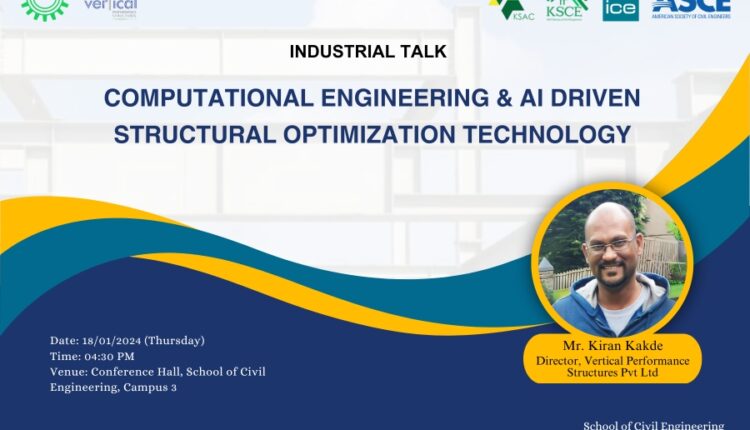Computational Engineering and AI Driven Structural Optimization Technology
KIIT Society of Civil Engineers (KSCE) hosted an Industrial Talk on the topic“Computational Engineering and AI-Driven Structural Optimization Technology” on 18th January 2024, in association with ICE and ASCE KIIT Student Chapters. The chief guest of the session was Mr. Kiran Kakde, Director of Vertical Performance Structures Pvt. Ltd. who was accompanied by the Guests of Honour, Mr. Ashok Kumar Basa, Executive VicePresident, WFEO and Mr. B.N Acharya, Director, DN Homes Pvt. Ltd. The event was graced with the presence of Prof. Dr. Sanjib Moulick, Dean, KIIT School of Civil Engineering, Prof.Dr. Madhu Lisha Pattanaik, Faculty Advisor KSCE, benevolent faculties, and students of the KIIT Civil Engineering department. The session started with a welcome address which was delivered by Prof. Dr. Satyajeet Nanda, Associate Professor, KIIT School of Civil Engineering.
The distinguished Guests of Honour, Mr. Ashok Kumar Basa, and Mr. B.N Acharya began their interaction with the faculty members and students with a warm and engaging demeanor. They shared their perspectives on the contemporary challenge of adapting to modernization across various aspects of life, emphasizing the societal inclination towards achieving the best results in the shortest possible time. They highlighted the significant evolution in the construction industry since the late 20th century, underscoring the importance of embracing changes and computerization for progress. It was emphasized, however, that while computerization is a valuable tool, it should be recognized as a means to an end and not a method in itself.
The session commenced with Mr. Kiran Kakde, the Guest Speaker, outlining the vision of Vertical Performance Structures Pvt. Ltd. Their goal is to become the leading integrated solution platform for structural steel construction, driven by technology, sustainable optimization, and innovation. Mr. Kakde presented visuals and explained the functionality of steel frames extensively employed in their construction projects. The company offers ribbed slabs, serving as effective one-way slabs, and allowing the installation of electrical ducts, such as AC ducts. Moving on, he delved into the discussion of various prevalent computational Engineering and Generative AI techniques in the industry. Examples includedHypermesh, an algorithm optimized for automotive design, and Generative AI, an algorithm tailored for machine bracket design. Additionally, Mr. Kakde introduced the Michell TrussDiagram (1904), a method considered ahead of its time.
Mr. Kakde went on to provide an in-depth explanation of the company’s patented technology, Direct Stress Path Mapping. This innovative approach is particularly well-suited for structures subjected to a loading of 8KN/m2 and spanning over 16 meters. This method presents several notable advantages, including enhanced structural strength, and a reduction in construction time achieved through a combination of offsite and onsite work. The sections are crafted using pre-cut steel of 350 and 450 MPa, and precision plasma cutters swiftly and accurately shape the plates. This process facilitates custom-built solutions.
A key feature of this approach is the majority of construction occurring offsite at the PEB(Pre-Engineered Building) unit. This not only minimizes flying dust and pollution on the construction site but also contributes to environmental sustainability. As steel, the primary component of the build is 100% recyclable, the Direct Stress Path Mapping methodology serves as a greener alternative to conventional construction methods. By incorporating advanced manufacturing techniques and environmentally conscious practices, the company is not only improving structural efficiency but also actively promoting a more sustainable and eco-friendly construction approach.
Mr. Kakde wrapped up his presentation by emphasizing the critical importance of optimization in the contemporary world. He highlighted how Direct Stress Path mapping could potentially serve as a valuable asset for future generations within the construction industry. Looking ahead, he outlined the prospective ecosystem of Vertical PerformanceStructures Pvt. Ltd., emphasizing a shift toward a Platform-as-a-Service (PAAS) model. This would encompass various components such as Software as a Service (SAAS), a platform for services covering design, fabrication, and erection by verified partners, procurement marketplace, training and placement services, certification programs, and advisory support for setting up fabrication facilities. Additionally, he introduced the concept of the Habitat Lab, an innovation lab and incubator specifically designed to focus on advancements in construction and building technology. This comprehensive vision aims to position the company at the forefront of industry evolution, fostering innovation and sustainable growth.
The event concluded with a very enthusiastic and engaging question-and-answer session. The audience exhibited a keen interest and involvement throughout the proceedings, making it a highly interactive experience. The session proved to be exceptionally enlightening, introducing the audience to cutting-edge patented technology relevant to the modern era. The anchor for the event was Amita Patra, Assistant Coordinator, KSCE. The vote of thanks was delivered by Divyanshu Ranjan, Coordinator, KSCE.


